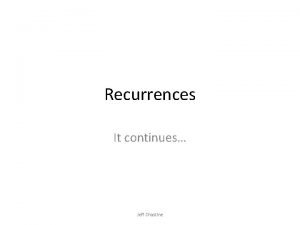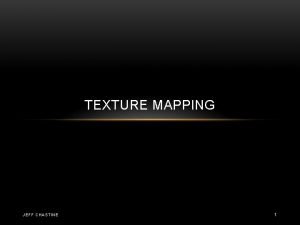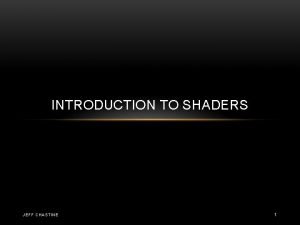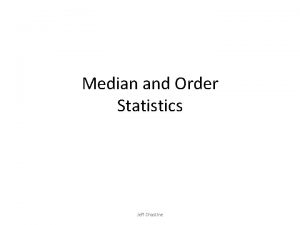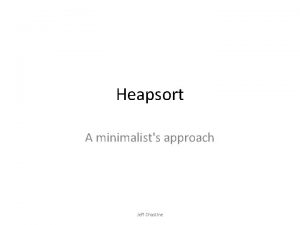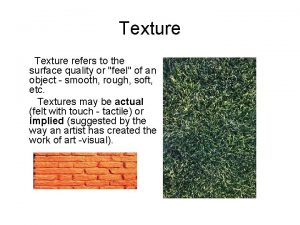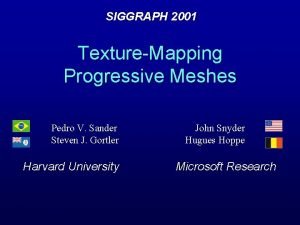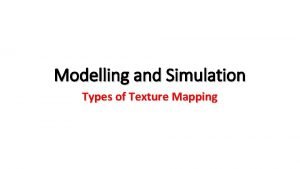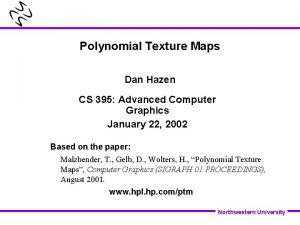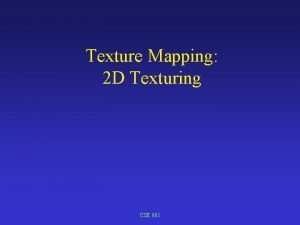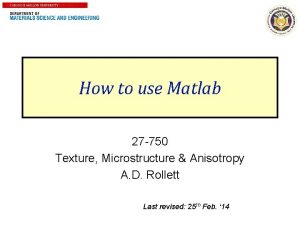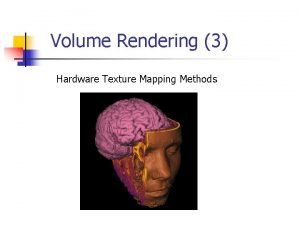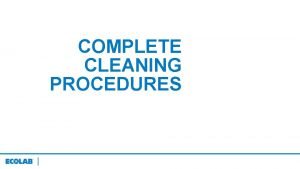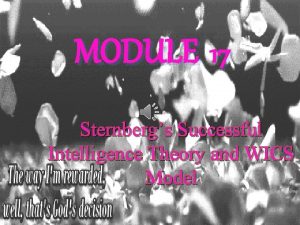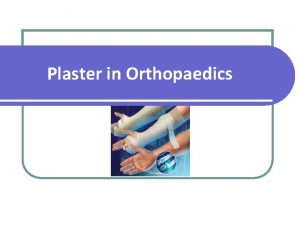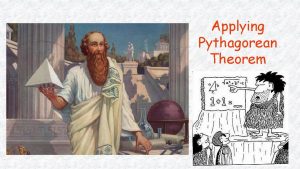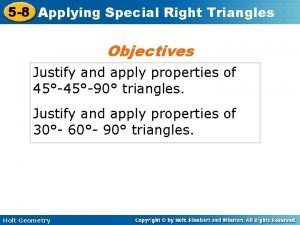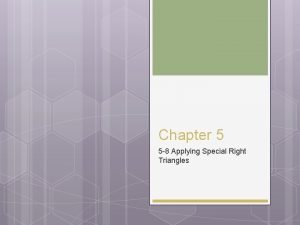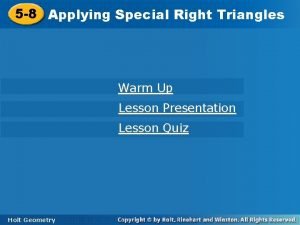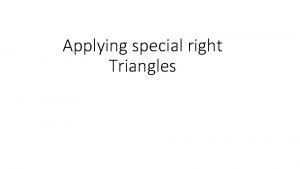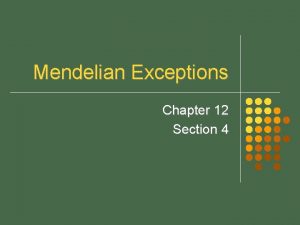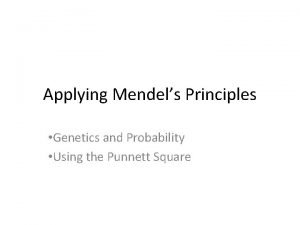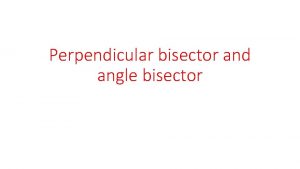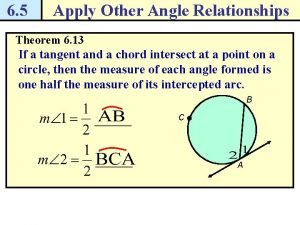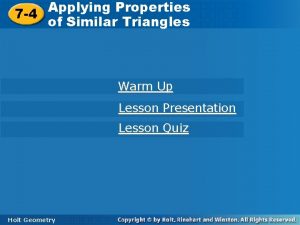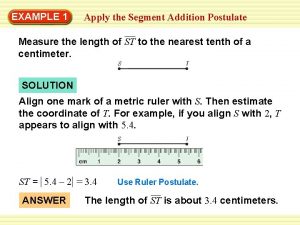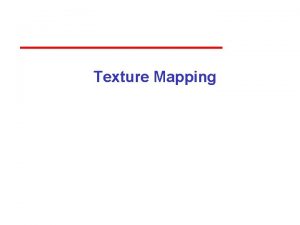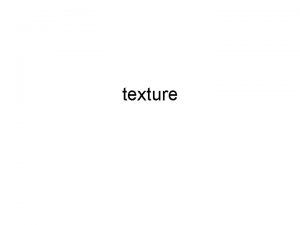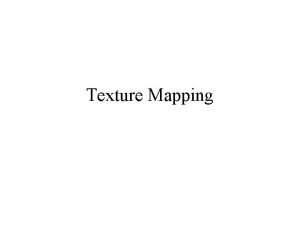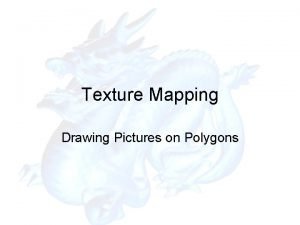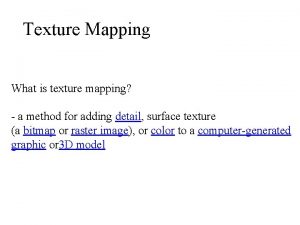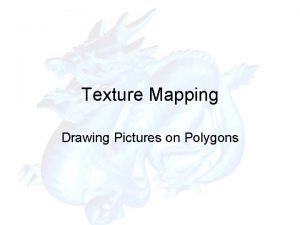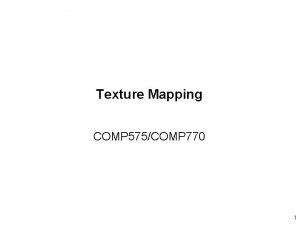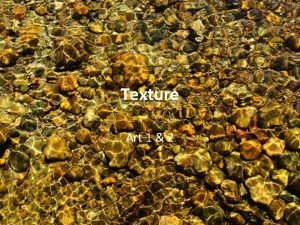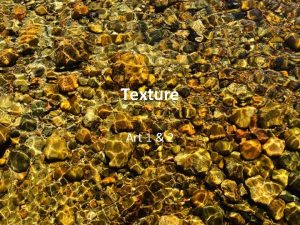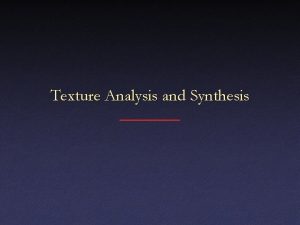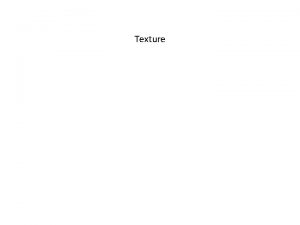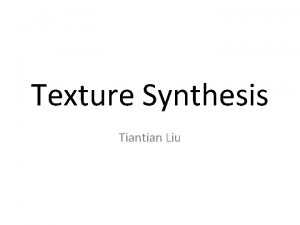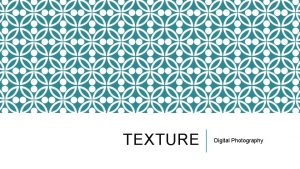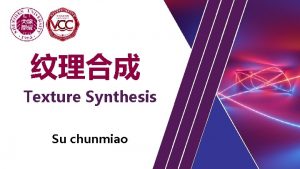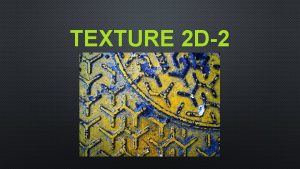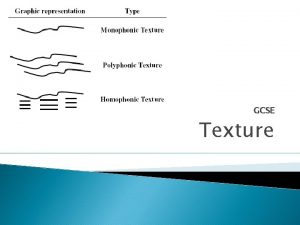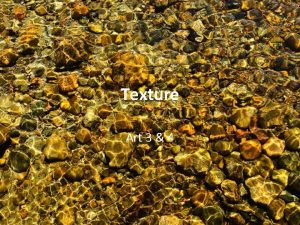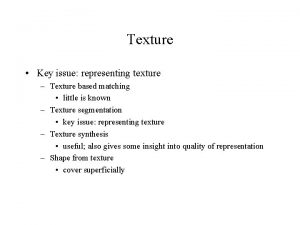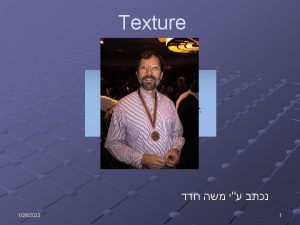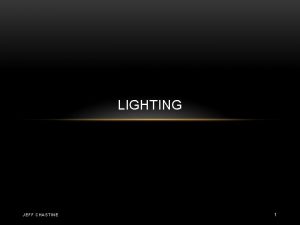TEXTURE MAPPING JEFF CHASTINE 1 TEXTURE MAPPING Applying







































- Slides: 39

TEXTURE MAPPING JEFF CHASTINE 1

TEXTURE MAPPING • Applying an image (or a texture) to geometry • 2 D images (rectangular) • 3 D images (volumetric – such as a CAT scan) • Adds realism to the scene • A vertex can have: • A 3 D position (x, y, z) – 3 floats • Normal (x, y, z) – 3 floats • Color? • A UV coordinate (s, t) – a. k. a. texture coordinates – 2 floats JEFF CHASTINE 2

THE PROBLEM ? Polygon to be textured JEFF CHASTINE 3

THE PROBLEM (0, 1) (1, 1) Polygon to be textured (0, 0) JEFF CHASTINE (1, 0) 4

THE PROBLEM (0, 1) (1, 1) Victory is mine! (0, 0) (1, 0) Linear interpolate each pixel! JEFF CHASTINE 5

WHAT IF IT’S STRETCHED? (0, 1) (1, 1) (0, 0) (1, 0) JEFF CHASTINE (0, 1) (0, 0) (1, 1) (1, 0) 6

WHAT IF IT’S STRETCHED? (0, 1) (1, 1) (0, 0) (1, 0) JEFF CHASTINE (0, 1) (0, 0) (1, 1) (1, 0) 7

WHAT HAPPENS NOW? (0, 1) (1, 1) (0, 2) (2, 2) Polygon to be textured (0, 0) JEFF CHASTINE (2, 0) (1, 0) 8

WHAT HAPPENS NOW? (0, 1) (1, 1) (0, 2) (0, 0) JEFF CHASTINE (2, 2) (2, 0) (1, 0) 9

WHAT HAPPENS NOW? (0, 1) (1, 1) (0, 2) (2, 2) (0, 0) (1, 0) (2, 0) (1, 0) (Note: there are other ways to handle UVs > 1. 0) JEFF CHASTINE 10


NON-PLANAR GEOMETRY (0, 1) (1, 1) (0, 0) (1, 0) JEFF CHASTINE 12

TEXTURE MAPPING • In the real world, models come with • Geometry • Normals • UV coordinates • A texture! • Now we must: • Load the positions, normals and UVs into the buffer • Somehow load a texture from file… Put it into a buffer • Somehow get that texture to the fragment shader! JEFF CHASTINE 13

IMAGE FILES • Bitmaps (BMP) • Common, and usually aren’t compressed • Contain header/meta info followed by pixel data • Are in BGR format, bottom row first! • Are easy to work with (just use my loader) • Won’t that be inefficient? • No – compression is on file side • Raw pixel data is sent to the buffer anyway! • What about JPEG, TGA, or raw image data? JEFF CHASTINE 14

INITIALIZING • • More IDs: • GLuint tex. Buffer. ID; // Open. GL variable • GLuint tex. Coord. ID, tex. ID; // Shader variables You’ll need a place to store the actual file data • GLubyte image[width][height][3]; • You’ll need a set of texture coordinates for the object: • GLfloat* uvs; • // Load these onto the buffer You also need to enable GL_TEXTURE_2 D • gl. Enable (GL_TEXTURE_2 D); Note: you can also call gl. Delete. Textures (GLsizei n, GLuint *textures); JEFF CHASTINE 15

BINDING AND LOADING • You’ll need to bind the texture (make this the active buffer for future operations) • Then, load the pixel data into the texture buffer gl. Gen. Textures(1, &tex. Buffer. ID); gl. Bind. Texture (GL_TEXTURE_2 D, tex. Buffer. ID); gl. Tex. Image 2 D (GL_TEXTURE_2 D, 0, GL_RGB, width, height, 0, GL_BGR, GL_UNSIGNED_BYTE, bitmap_data); The type of texture **GL_TEXTURE_1 D, GL_TEXTURE_3 D, GL_TEXTURE_CUBE_MAP JEFF CHASTINE 16

BINDING AND LOADING • You’ll need to bind the texture (make this the active buffer for future operations) • Then, load the pixel data into the buffer gl. Gen. Textures(1, &tex. Buffer. ID); gl. Bind. Texture (GL_TEXTURE_2 D, tex. Buffer. ID); gl. Tex. Image 2 D (GL_TEXTURE_2 D, 0, GL_RGB, width, height, 0, GL_BGR, GL_UNSIGNED_BYTE, bitmap_data); The level of this texture for “mipmapping” - later JEFF CHASTINE 17

BINDING AND LOADING • You’ll need to bind the texture (make this the active buffer for future operations) • Then, load the pixel data into the buffer gl. Gen. Textures(1, &tex. Buffer. ID); gl. Bind. Texture (GL_TEXTURE_2 D, tex. Buffer. ID); gl. Tex. Image 2 D (GL_TEXTURE_2 D, 0, GL_RGB, width, height, 0, GL_BGR, GL_UNSIGNED_BYTE, bitmap_data); How Open. GL should store this data internally **GL_RED, GL_GREEN, GL_BLUE, GL_ALPHA, GL_RGB, GL_BGR, GL_RGBA… JEFF CHASTINE 18

BINDING AND LOADING • You’ll need to bind the texture (make this the active buffer for future operations) • Then, load the pixel data into the buffer gl. Gen. Textures(1, &tex. Buffer. ID); gl. Bind. Texture (GL_TEXTURE_2 D, tex. Buffer. ID); gl. Tex. Image 2 D (GL_TEXTURE_2 D, 0, GL_RGB, width, height, 0, GL_BGR, GL_UNSIGNED_BYTE, bitmap_data); Obviously the width and height, but why not size of the buffer? JEFF CHASTINE 19

BINDING AND LOADING • You’ll need to bind the texture (make this the active buffer for future operations) • Then, load the pixel data into the buffer gl. Gen. Textures(1, &tex. Buffer. ID); gl. Bind. Texture (GL_TEXTURE_2 D, tex. Buffer. ID); gl. Tex. Image 2 D (GL_TEXTURE_2 D, 0, GL_RGB, width, height, 0, GL_BGR, GL_UNSIGNED_BYTE, bitmap_data); The width of a border (if you want one) JEFF CHASTINE 20

BINDING AND LOADING • You’ll need to bind the texture (make this the active buffer for future operations) • Then, load the pixel data into the buffer gl. Gen. Textures(1, &tex. Buffer. ID); gl. Bind. Texture (GL_TEXTURE_2 D, tex. Buffer. ID); gl. Tex. Image 2 D (GL_TEXTURE_2 D, 0, GL_RGB, width, height, 0, GL_BGR, GL_UNSIGNED_BYTE, bitmap_data); The format of the pixel data we’re giving it **GL_UNSIGNED_SHORT_5_6_5, GL_UNSIGNED_SHORT_4_4, GL_UNSIGNED_INT_8_8, . . . JEFF CHASTINE 21

BINDING AND LOADING • You’ll need to bind the texture (make this the active buffer for future operations) • Then, load the pixel data into the buffer gl. Gen. Textures(1, &tex. Buffer. ID); gl. Bind. Texture (GL_TEXTURE_2 D, tex. Buffer. ID); gl. Tex. Image 2 D (GL_TEXTURE_2 D, 0, GL_RGB, width, height, 0, GL_BGR, GL_UNSIGNED_BYTE, bitmap_data); The raw pixel data itself JEFF CHASTINE 22

TEXTURE UNITS • A piece of hardware that has access to a texture image • Select that unit with gl. Active. Texture (GL_TEXTURE 0); • For multiple layers/effects, could activate GL_TEXTURE 1, GL_TEXTURE 2, … • For now, just stick with GL_TEXTURE 0! JEFF CHASTINE 23

KNOWN PROBLEMS IN TEXTURE MAPPING • What should you do if a texture coordinate is out of range (e. g. > 1. 0)? • We can modify the behavior using gl. Tex. Parameterf() • GL_CLAMP • GL_REPEAT • GL_CLAMP_TO_BORDER • GL_MIRRORED_REPEAT • Others as well gl. Tex. Parameterf (GL_TEXTURE_2 D, GL_TEXTURE_WRAP_S, GL_REPEAT); JEFF CHASTINE 24

TEXTURE WRAPPING (ORIGINAL 1 -TO-1 MAPPING) 1, 1 0, 0 JEFF CHASTINE 25

TEXTURE WRAPPING (GL_REPEAT) 4, 4 0, 0 JEFF CHASTINE 26

TEXTURE WRAPPING (GL_CLAMP) – REALLY NOT USEFUL… 4, 4 0, 0 JEFF CHASTINE 27

TEXTURE WRAPPING (GL_CLAMP) AND (GL_REPEAT) 4, 4 0, 0 JEFF CHASTINE 28

TEXTURE WRAPPING (GL_CLAMP_TO_BORDER) 4, 4 0, 0 JEFF CHASTINE 29

TEXTURE WRAPPING WHY MIRRORED? (GL_MIRRORED_REPEAT) JEFF CHASTINE (GL_REPEAT) 30

MINIFICATION AND MAGNIFICATION • At some depth, one screen pixel == one texel (texture element) • Closer, many screen pixels for few texels (magnification) • Farther, many texels for few screen pixels (minification) • What should you do if a one screen pixel is in between multiple texels? • What happens if several parts of the image map to the same pixel? • Change the GL_TEXTURE_MAG_FILTER to: • GL_NEAREST • GL_LINEAR JEFF CHASTINE 31

GL_NEAREST JEFF CHASTINE 32

GL_LINEAR JEFF CHASTINE 33

ANOTHER APPROACH - MIPMAPPING • Have several images that are pre-rendered • Open. GL picks the most approach one (or interpolates) • gl. Generate. Mipmap (GLenum target); http: //en. wikipedia. org/wiki/Mipmap JEFF CHASTINE 34

SAMPLERS • In your shaders, textures are accessed using a sampler: • sampler 1 D • sampler 2 D ** • sampler 3 D • sampler. Cube • Samplers are uniform (which makes sense) • Set that sampler in Open. GL using: tex. ID = gl. Get. Uniform. Location(prog. ID, “texture”); gl. Uniform 1 i (tex. ID, 0); // This is GL_TEXTURE 0 JEFF CHASTINE 35

gl. Enable(GL_TEXTURE_2 D); gl. Gen. Textures (1, &tex. Buffer. ID); gl. Bind. Texture (GL_TEXTURE_2 D, tex. Buffer. ID); gl. Tex. Image 2 D (GL_TEXTURE_2 D, 0, GL_RGB, width, height, 0, GL_BGR, GL_UNSIGNED_BYTE, bitmap_data); gl. Tex. Parameterf(GL_TEXTURE_2 D, GL_TEXTURE_WRAP_S, GL_MIRRORED_REPEAT); gl. Tex. Parameterf(GL_TEXTURE_2 D, GL_TEXTURE_WRAP_T, GL_MIRRORED_REPEAT ); gl. Tex. Parameterf(GL_TEXTURE_2 D, GL_TEXTURE_MAG_FILTER, GL_NEAREST); gl. Tex. Parameterf(GL_TEXTURE_2 D, GL_TEXTURE_MIN_FILTER, GL_NEAREST); tex. Coord. ID = gl. Get. Attrib. Location(prog. ID, “s_v. Tex. Coord"); gl. Enable. Vertex. Attrib. Array(tex. Coord. ID); gl. Vertex. Attrib. Pointer(tex. Coord. ID, 2, GL_FLOAT, GL_FALSE, 0, BUFFER_OFFSET(offset. To. UVs. In. Bytes); tex. ID = gl. Get. Uniform. Location(shader. Program. ID, “texture”); gl. Active. Texture(GL_TEXTURE 0); gl. Uniform 1 i(tex. ID, 0); JEFF CHASTINE 36

YOUR VERTEX SHADER (TEXTURING ONLY) #version 150 in vec 4 s_v. Position; in vec 4 s_v. Normal; in vec 2 s_v. Tex. Coord; out vec 2 tex. Coord; // // From our Open. GL program!! The normal of the vertex In from Open. GL Going out to the shader // Remember, uniforms are the same for a vertices. uniform mat 4 p; // This is perspective matrix uniform mat 4 mv; // This is the model-view matrix // Other stuff cut… void main () { gl_Position = p*mv*v. Position; tex. Coord = s_v. Tex. Coord; } JEFF CHASTINE // Interpolate for frag shader 37

FRAGMENT SHADER #version 150 out vec 4 f. Color; // Final output in vec 2 tex. Coord; // From the vertex shader uniform sampler 2 D texture; // How to access the texture void main () { f. Color = texture 2 D (texture, tex. Coord); } JEFF CHASTINE 38

JEFF CHASTINE 39
 Jeff chastine
Jeff chastine Jeff chastine
Jeff chastine Jeff chastine
Jeff chastine Jeff chastine
Jeff chastine Order statistics median
Order statistics median Jeff chastine
Jeff chastine Refers to the surface quality
Refers to the surface quality Texture mapping progressive meshes
Texture mapping progressive meshes Types of texture maps
Types of texture maps What is polynomial texture mapping (ptm)?
What is polynomial texture mapping (ptm)? 2d texture mapping
2d texture mapping Matlab texture mapping
Matlab texture mapping Summed area table
Summed area table Texture mapping algorithm
Texture mapping algorithm Terjemahan
Terjemahan Memory parameters
Memory parameters Forward mapping vs backward mapping
Forward mapping vs backward mapping Food mixer
Food mixer Wics model activities
Wics model activities Applying learning theories to healthcare practice
Applying learning theories to healthcare practice Phenotype and genotype
Phenotype and genotype Types of pop in orthopedics
Types of pop in orthopedics Applying critical approaches to literary analysis
Applying critical approaches to literary analysis Applying the pythagorean theorem homework 3
Applying the pythagorean theorem homework 3 Chapter 3 applying learning theories to healthcare practice
Chapter 3 applying learning theories to healthcare practice Alternate interior angles conjecture
Alternate interior angles conjecture Angle relationship definitions
Angle relationship definitions 5-8 applying special right triangles
5-8 applying special right triangles 5-8 practice b applying special right triangles
5-8 practice b applying special right triangles 8-3 lesson quiz geometry
8-3 lesson quiz geometry Find y
Find y Light cured gel enhancements should be maintained _____.
Light cured gel enhancements should be maintained _____. Queer theory in literary criticism ppt
Queer theory in literary criticism ppt Andalusian chicken incomplete dominance
Andalusian chicken incomplete dominance Applying mendels principles
Applying mendels principles Segment fg is the angle bisector of
Segment fg is the angle bisector of  Applying angle relationships
Applying angle relationships 7-4 applying properties of similar triangles
7-4 applying properties of similar triangles Applying agile approach in erp implementation
Applying agile approach in erp implementation Ruler postulate example
Ruler postulate example
